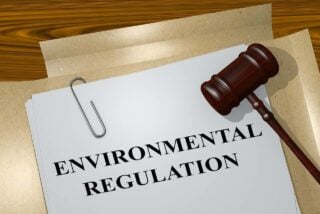
The U.S. Environmental Protection Agency (EPA) released its Final Risk Evaluation for Asbestos, Part 1: Chrysotile Asbestos at the end of 2020. The EPA analysis found chrysotile asbestos poses a risk to human health.
In the document, the federal organization determined all six current uses of chrysotile asbestos are hazardous to human health. The EPA evaluates asbestos risk to humans and the environment. The organization found the current uses of chrysotile asbestos are not a risk to the environment.
EPA Finds Current Chrysotile Asbestos Use Dangerous for Humans
The EPA released its Final Risk Evaluation for Asbestos, Part 1: Chrysotile Asbestos on December 30, 2020. The document analyzed the risk to humans and the environment from current uses of asbestos.
The EPA split up analyses of current uses of asbestos from past uses. The risk evaluation from December 2020 only analyzed chrysotile asbestos. The EPA determined chrysotile asbestos is the only form of the carcinogen still imported to the United States. Asbestos is no longer mined in the U.S., which kept the other five forms of asbestos from this analysis.
The EPA determined all six current uses of chrysotile asbestos cause “unreasonable risks to human health.”
Why Is Asbestos Dangerous?
The risks associated with asbestos exposure have been known for decades. Asbestos is a known cancer-causing mineral and is banned in many countries.
Asbestos exposure can cause mesothelioma, lung cancer and asbestosis, among other health conditions.
Who Is at Risk From Current Asbestos Uses?
The EPA’s current asbestos use analysis found all six current uses cause risk to:
- Workers
- Occupational non-users
- Consumers
- Bystanders
Risk While at Work
According to findings, the risk is greatest among workers not using respiratory protection. The EPA still found risk when workers used basic respiratory protection. The analysis shows the risk persisted even with the use of advanced respiratory protection.
What Were the Six Categories of Asbestos Use Analyzed by the EPA?
The EPA analyzed the six current uses of asbestos in the United States. Specifically, the agency looked at:
- Chlor-alkali diaphragms
- Sheet gaskets
- Other gaskets
- Oilfield brake blocks
- Aftermarket automotive brakes/linings
- Other vehicle friction products
Chlor-alkali diaphragms are the only current use that incorporates raw chrysotile asbestos. The other five current uses are asbestos products imported into the United States. The products are manufactured with raw asbestos outside of the U.S.
Next Steps Following the EPA’s Determination
Following the release of this Final Risk Evaluation for Asbestos, Part 1: Chrysotile Asbestos, the EPA must present a plan to mitigate the risk.
Reducing the risk to human health caused by chrysotile asbestos may include:
- Regulating chrysotile asbestos use
- Banning chrysotile asbestos
As the EPA addresses these unreasonable risks, it will take public comments on risk management actions. The EPA has one year to propose a plan and take public comments
Analysis of Past Uses of Asbestos
The EPA still needs to evaluate risk from past uses of asbestos. Past uses of asbestos include uses now banned in the United States, including certain building materials and other types of asbestos. Many of these legacy uses are still circulating today. Consumers may encounter these uses in their homes, schools and other buildings.
The EPA plans to release a scoping document by mid-2021. The document will detail the past uses to be analyzed.




